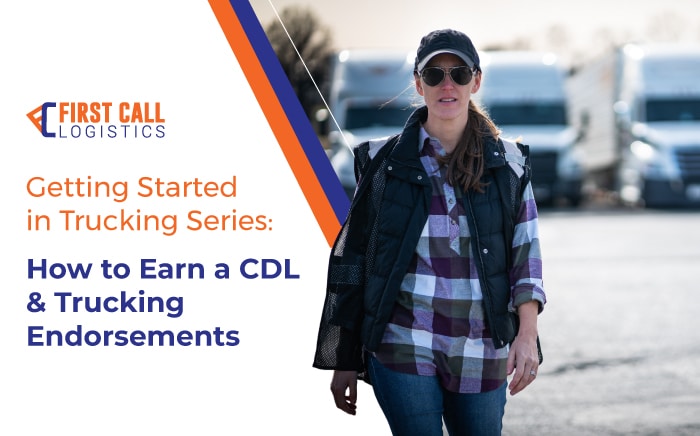How to Earn a CDL and Trucking Endorsements

The First Step Toward Becoming a Commercial Driver
To begin, you’ll have to pass a regular driver’s license exam if you haven’t already. This serves as a prerequisite for working toward a commercial learner’s permit and driver’s license (we’ll discuss specific classifications and endorsements further below). Next, most (though not all) long-haul employers will expect applicants to hold at least a high school diploma or GED credential.
With these in hand, you’ll be prepared to receive your professional training through a trucking company, community college, or private driving school. There is generally a tuition cost associated with this specialized training, but it can often be discounted, aided, or reimbursed by companies in need of drivers.
Driver Requirements
There are a few other items you’ll need to clear before earning a CDL and endorsements, many of which are standard across any line of employment:
- Be at least 18 years old to drive within state lines or 21 years old to cross state lines
- Hold a clean driving record
- Offer proof of state residency
- Have a valid social security number
- Hold proof of insurance
- Pass periodic drug tests
- Get a physical, document medical history, and maintain a current Medical Examiner’s Certificate (MEC)
- Pass a background check
CDL Classes and Testing
Your truck driving program of choice will have you fill out a CDL learner’s permit application. Obtaining this learner’s permit and passing a general knowledge test will qualify you for getting behind the wheel of a commercial vehicle under the watchful eye of an instructor. Training consists of both driving practice and classroom instruction, all designed to ready you for final CDL testing, endorsements, and life on the open road.
There are three classes of CDLs drivers can receive:
- Class A: This is probably what first comes to mind when you consider a job in trucking — tractor-trailers, flatbeds, livestock carriers, tankers, and other heavy-duty long-haul type vehicles are only driven by Class A-certified drivers. Class A vehicles are those with a gross combination weight rating (GVWR) of 26,001 or more pounds, provided the towed vehicle is heavier than 10,000 pounds. Class A licenses also allow operation for most Class B and C vehicles, making this the ideal class for commercial drivers.
- Class B: Required to operate any commercial with a gross combination weight rating of 26,001 or more pounds, or tow a vehicle weighing less than 10,000 pounds. Drivers holding Class B licenses operate straight trucks, city and school buses, box trucks, and dump trucks with small trailers.
- Class C: For lighter commercial vehicles or those transporting large groups of passengers, a Class C license is required. Given the proper endorsements, Class C licenses qualify drivers for operating HazMat vehicles and passenger vans.
A Brief Look into Endorsements
Endorsements signify drivers are trained in handling specialty equipment and cargo beyond standard commercial goods. Special endorsements might include hazardous materials (hazmat), passenger vehicles, or vehicles equipped with air brakes. Though endorsements do require additional study and testing, they make for safer, more versatile drivers — and companies love to hire drivers capable of handling all kinds of freight. Hazmat-certified drivers are put under particularly careful scrutiny and must pass a security threat assessment before progressing.
Here are some of the most common endorsements that can aid new drivers in landing a job (or qualifying for more pay):
- H – Hazmat (Hazardous Materials)
- N – Tanker
- X – Tanker/Hazmat Combination
- T – Doubles and Triples
- P – Passenger
- S – School Bus
Where to go From Here
Receiving proper training will form the foundation for your success as a driver, which means choosing a reputable driving school is crucial. Many training schools are also involved in scholarship programs, grants, or government-funded training for workers who’ve lost their jobs. Feel free to check our own site’s resource page for more info on receiving your CDL and officially launching your career in the shipping industry.
Learn More About Carrier Opportunities with First Call Logistics
At First Call, we’re committed to supporting our carrier network with the resources necessary to be successful. To learn more about First Call’s dedicated and transactional freight opportunities, flexible payment options, and 24/7 carrier support, contact us today.
The 3PL You’ve Been Looking For
Building and managing cost-efficient supply chains is a full-time job. First Call’s rare combination of in-house assets, expert problem-solving and track record of stellar customer service makes us the 3PL of choice for carrier partners looking to make the most of their miles.
“First Call always paid on time and would get me back-hauls whenever possible which was great.”
– Wayne, Carrier
More Resources for FCL Carriers:
- Article: Is a Trucking Career Right for Me?
- Article: Careers in Truck Driving: Choosing the Right Job
- Article: A Look at 9 Kinds of Trucking Jobs
- Article: Reviewing Your CDL Training Options
- Article: Advantages of Driving for Private, For-Hire & Independent Trucking Companies
- Article: Six Things You Should Know About Hazmat Shipping
Get the latest supply chain news and updates directly to your inbox.